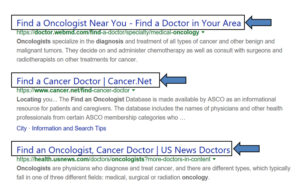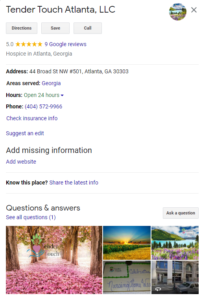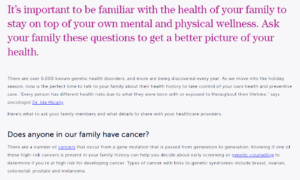
Healthcare marketers often overlook the most straightforward tasks to get their websites ranking on Google. Though they may be considered “low-hanging fruits” in SEO, these simple tasks can actually have a significant impact on your organic traffic. Let’s walk through some easy healthcare SEO optimizations you may be missing out on and how they can improve SEO rankings and deliver big results for your marketing efforts.
Healthcare marketers, take note—it’s time to start seeking out some easy SEO wins. Budgets are being cut, and advertising is being pulled back, making your jobs that much more difficult. You may not be able to reach healthcare consumers through Google Ads or other paid channels, but you can organically. With things the way they are, there’s no time like now to invest in your SEO foundation and optimize for organic search.
Sometimes, the simplest fixes are the most overlooked. Adjusting meta-titles and meta-descriptions is one such easy fix that you just may have left out inadvertently. While Google’s search bot uses the best AI, whose algorithms they improve all the time, it still helps to contextualize your web page.
Take time to edit your title tags, ensuring you describe page content accurately and use brief but descriptive titles. You’ll also want to include high-value keywords and use a unique keyword to target on every page. Update meta descriptions, too, ensuring they accurately reflect what is on the page. Keep them between 150 and 160 characters and include keywords naturally.

Title tags tell Google what your site is about and persuades users to click when they scan the SERP.
Pro tip? The Yoast SEO plugin for WordPress can help you manage your meta description for blog posts, making your life that much easier.
When patients are looking for a doctor and arrive at your website, your service pages should provide the solution, not more searching and questions. Too often, we see healthcare websites with bare-bones service pages that fail to answer patients’ most basic questions. If your pages are thin, plump them up—enhancing thin pages can make a significant impact on search rankings.
To do this, strategize with your executive team on the priority service lines that can impact the bottom line the most, then focus your optimization efforts on those pages first, leveraging the following:
Want more tips on how to improve your thin content? Take a look at our detailed article on the topic.
Local SEO is critical to delivering the relevance expected by healthcare consumers. That means optimizing your site, so it appears in Map Pack and Google Maps. How can you do that? Review your GBP profile regularly, keeping it up to date. Make sure to include:

Having a complete GBP profile makes your healthcare facility stand out among the rest.
For a deep dive into the topic, look at our article about boosting your local rankings.
Got location pages on your site? Great. Now, are they easily findable? More to the point, are they engaging for a user trying to make an appointment at that location? Make sure your location pages include all the details your healthcare consumers are interested in, including:
Also include a link to your Google Business Profile—an easy way to send a signal to a search engine that connects your location page on your website to your listings. This small touch is often overlooked. Plus, it helps users connect immediately to a map view of your location.
Site speed is currently an SEO ranking factor for Google. Did you know that? The faster your website is, the higher chance you have to rank higher up in the SERPs. This goes for desktop and mobile, too.
How can you improve your site speed? First, start by testing your site using a website like Google Page Speed Insights, Google Core Web Vitals Report, etc. Once you have an idea of your site speed, do the following to improve it, as needed:
Still not getting up to speed? Sometimes, you may need to make more fundamental changes to your website structure. Learn more about that here.
Internal links still matter, and they can help add link authority to pages on your site. The more internal links there are pointing to a page, the more Google understands the page is valuable and boosts it in the SERPs. An added bonus? Internal links also help users stay engaged with the content and stay on your site. When adding internal links, consider the following:

Internal links help both Google and users find additional information on your website.
Finally, you’ll want to revise your headlines on crucial service pages. Headings are important for several reasons. Heads help to break up long-form content making it easier to read. The second and most essential reason headers are important is to help the user and Google understand what the content is about and how it’s organized. Keep the following in mind when revising your headers:
Make sure you also use headers to break up your page—you never want large blocks of text. Make those headings relevant and captivating, too; you want your readers to be intrigued and informed about the content within that section.
Healthcare SEO optimizations don’t need to take up all your time and effort. With a few quick and easy changes, you can improve SEO rankings, no matter what’s happening to your budget. By making these small but impactful tweaks, you will be well on your way to more engaging content and happier healthcare consumers.

Alex Membrillo
CEO
The original version of this page was published at: https://www.cardinaldigitalmarketing.com/healthcare-resources/blog/easy-healthcare-seo-optimizations-improve-rankings/
As a leading healthcare digital marketing agency, Cardinal Digital Marketing has partnered with some of the most recognizable brands in the country. We’ve helped countless multi-location organizati... Read more
Healthcare marketers must strike a balance between effective marketing strategies and strict privacy rules. Here's our list of HIPAA-compliant marketing technologies healthcare ...read more
When evaluating SEO performance, multi-location brands face a number of common challenges. In this blog post, we explore these challenges, while laying out a three-step approach to ...read more
In the race to expand, fold in new locations, and acquire new patients, many DSOs face problems of scale. In this blog post, we look at the role of marketing operations in helping ...read more
By now, you know that search engine optimization (SEO) is a longer-term play. But you don’t have to be in the dark about the progress of your strategy. That’s the idea ...read more